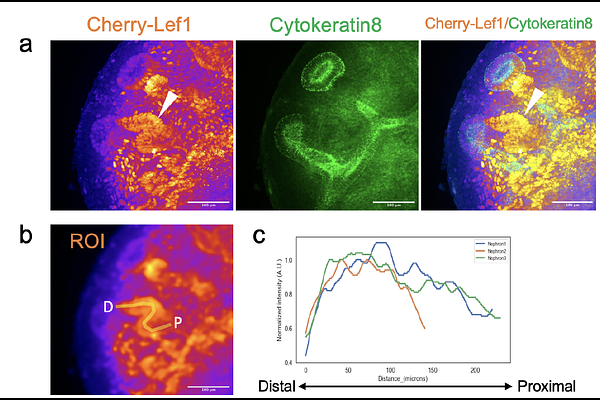Quantitative high-resolution imaging of mouse nephron formation to study Wnt signaling dynamics

Quantitative high-resolution imaging of mouse nephron formation to study Wnt signaling dynamics
Tsuchida-Straeten, N.; Hammer, S.; Halavatyi, A.; Tischer, C.; Pereira, G.; Simons, M.
AbstractIntroduction Nephron formation is initiated when Wnt9b from the ureteric bud acts on nephron progenitor cells in the metanephric mesenchyme. For mouse embryonic kidneys, this process can be studied in real time using ex vivo organ cultures. Previous imaging methods relied on Transwell filters with a long distance between objective and sample as well as low signal-to-noise ratio due to the filter membrane. Moreover, Wnt signaling was previously visualized with the expression reporters TCF/Lef:H2B-GFP. Methods We developed an ex vivo culture system based on low-volume media and fibronectin coating for real time imaging. We further made use of endogenously tagged Cherry-Lef1 and Ctnnb1-Venus reporter mouse lines as reporters for Wnt signaling during kidney development. Furthermore, we established an adaptive feedback microscopy pipeline to track the signal with high resolution. Results Using these approaches, we found that Cherry-Lef1 proteins are only expressed in the nascent nephron and derivatives. Expression is graded along distal-proximal nephron axis suggesting that the ureteric bud-derived Wnt9b is controlling its expression. Interestingly, we observed that Cherry-Lef1 gradient shifts from distal to proximal axis during nephron patterning. {beta}-catenin-Venus, on the other hand, first became visible in the ureteric bud, then in the nascent nephron after Lef1. Conclusions Using a novel imaging approach we demonstrate a dynamic regulation of Wnt signaling that correlates with nephrogenesis in mouse kidney development. Combined with our two new Wnt signaling reporters, nephron formation can be studied in real-time with high resolution.